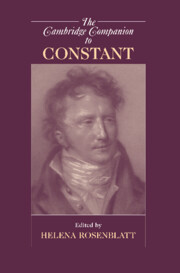Book contents
- Frontmatter
- Introduction
- 1 Benjamin Constant: Life and Work
- Part I The Political Thinker and Actor
- 2 Liberalism’s Lucid Illusion
- 3 The Liberty to Denounce: Ancient and Modern
- 4 Constant’s Idea of Modern Liberty
- 5 Benjamin Constant and the Terror
- 6 Constant’s Thought on Slavery and Empire
- 7 Benjamin Constant as a Second Restoration Politician
- Part II The Psychologist and Critic
- Part III The Analyst and Historian of Religion
- Conclusion
- 15 Eclipses and Revivals Constant’s: Reception in France and America 1830-2007
- Bibliography
- Index
- Series List
5 - Benjamin Constant and the Terror
from Part I - The Political Thinker and Actor
Published online by Cambridge University Press: 28 July 2009
- Frontmatter
- Introduction
- 1 Benjamin Constant: Life and Work
- Part I The Political Thinker and Actor
- 2 Liberalism’s Lucid Illusion
- 3 The Liberty to Denounce: Ancient and Modern
- 4 Constant’s Idea of Modern Liberty
- 5 Benjamin Constant and the Terror
- 6 Constant’s Thought on Slavery and Empire
- 7 Benjamin Constant as a Second Restoration Politician
- Part II The Psychologist and Critic
- Part III The Analyst and Historian of Religion
- Conclusion
- 15 Eclipses and Revivals Constant’s: Reception in France and America 1830-2007
- Bibliography
- Index
- Series List
Summary
THE TERROR AND ITS LEGACY
September 5, 1793, was a day of revolutionary agitation and violence in Paris. The sans-culottes invaded the seat of the Convention demanding bread for the people and the guillotine for the enemies of the Revolution. There was nothing exceptional about the event, however. For several months Paris had been periodically rocked by popular uprisings led by more or less obscure agitators and always culminating in the same demands: for more food, price controls, stabilization of the assignat, punishment of traitors and moderates, and surveillance of suspects. A mixture of economic demands and political obsessions (of a repressive type) proceeded systematically from the streets, dominated by the sans-culottes and enragés, to the Convention, the seat of legal power.
Faced with this situation, which was aggravated by the insurrection in the Vendée and by the war, the Convention, led by the Jacobins, had already adopted a series of emergency measures. In March it had instituted the Revolutionary Tribunal to judge “suspects,” as well as the “committees of surveillance” to identify them. In April it had created the Committee of Public Safety, which deliberated in secret and was authorized to order immediate execution of its decisions. Also in April it had dispatched representatives to the army and invested them with unlimited powers, and in the following months it decreed ceilings on grain and wheat prices (the famous “maximum”), fixed the value of the assignat, and established a tax on large fortunes.
- Type
- Chapter
- Information
- The Cambridge Companion to Constant , pp. 92 - 114Publisher: Cambridge University PressPrint publication year: 2009
- 3
- Cited by



